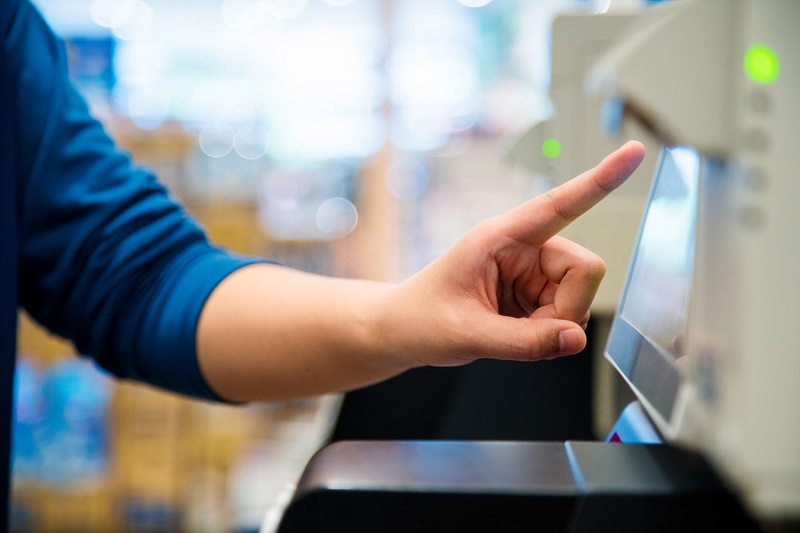COVID-19 has created an environment that has required many small businesses to adapt and evolve in order to survive. Tools such as self-service kiosks that enable the automation of simple processes and allow for faster communication and easier interactions are one such adaptation that has helped small businesses across a range of industries to not just survive, but thrive. Today we will look at the pros and cons of self-checkout kiosks and how they can increase revenue and customer satisfaction while lowering costs.
What are the advantages of self-checkout kiosks for small businesses’ customers?
Self-checkout kiosks allow small businesses to interact with their customers and quickly address their needs. This includes checking stock of an item or helping them locate it in the store, or assisting them with paying for their order. Since many customers prefer to help themselves either due to the convenience of self-service kiosks or for reasons of safety, a kiosk gives shoppers options for service without requiring interaction with a staff member.

Why are self-checkout solutions gaining popularity with small businesses?
Self checkout solutions have surged in popularity due to COVID-19. The pandemic has increased the need for contactless checkout while also providing an avenue for businesses to cut overhead in order to stay in operation. In 2020 and 2021, contactless checkout continues to be in-demand as it provides another layer of safety for both the shopper and store staff. Even before the pandemic, these kiosks’ popularity was growing as many customers have found them to be more convenient and efficient than staffed checkout lanes.
What types of small businesses use self-checkout kiosks?
Many small businesses utilize self-checkout kiosks and tablets these days but the early adopters include grocery stores, retail chains and fast-casual restaurants.
Grocery Stores
Grocery stores were the first to utilize self-checkout technology in order to handle overflow at the busiest times, as well as provide customers with smaller orders the flexibility to pay and go more quickly than with a typical staffed checkout lane. Customers simply bring their items up to the kiosk and scan the barcodes, then pay with cash or credit cards.
Retail Stores
Many retail stores use self-checkout kiosks to help customers make their purchases more quickly, without waiting in long lines. This provides a simplified experience for the shopper as they can simply purchase the items they need without having to wait in line for a sales associate to be free. Additionally the kiosks provide the chance for businesses to upsell other items to promote loyalty programs, but in a format that is less intrusive for the customer.
Restaurants & Food service
Sit-down, fast-casual and quick-service restaurants all use self-service kiosks to assist guests in ordering and paying for food. This cuts back on the number of staff needed on hand as customers can simply order with a tablet or a large touch screen, whether at the restaurant’s entrance, or at their table. Self-service ordering is also more accurate as it lessens the chance of human error, resulting in fewer mistakes. This means that customers generally get what they ask for as they do not have to rely on servers to take down their orders correctly. These checkout solutions can also dramatically reduce the amount of time customers must wait to receive their orders, expediting the process and putting less strain on staff.
What are the benefits of self-checkout kiosks for small businesses?
Self-checkout kiosks benefit small businesses in a number of ways:
Reduced overhead
Kiosks allow businesses to operate with fewer costs, which results in lower overhead. Simply installing a single self-checkout kiosk can drastically reduce the cost of maintaining a business, while allowing staff more time to address customer needs, which is much more efficient and results in a better customer experience.
Faster checkout process
Kiosks allow customers to purchase goods and services without waiting in long lines. Many times, especially in grocery stores, there are guests who have only a few items, and offering self-checkout kiosks allows these guests to quickly buy their goods and leave in a reasonable amount of time.
The negatives of self checkouts
While self-checkout kiosks have many excellent benefits, there are a few drawbacks as well. Here are the most common:
Impersonal
While they may be quite convenient, self-checkout kiosks can also seem impersonal or confusing, especially to those customers who are less comfortable with digital technology . Some customers enjoy the experience of interacting with employees and staff, and, unfortunately with self-checkout, there are fewer opportunities to do so.
Potential theft
Another potential risk of self-checkout is that the potential for theft may increase if there is no employee to monitor the checkout areas. However, this is easily remedied by having an employee available in the checkout area to both provide customer service when needed, and keep an eye out for potential problems.
What factors should small businesses consider when deciding whether or not to purchase a self-checkout kiosk?
1. Evaluate the flow of store traffic
Before introducing a self-checkout system, it’s important to evaluate the flow of the store. If there has been a consistent increase in traffic, then it may be time to consider a self-checkout kiosk. A self-checkout system can easily handle large volumes of traffic but is less ideal for businesses that don’t see increases in foot traffic throughout the day.
2. Can the products or services offered be easily purchased via self-checkout?
In addition to evaluating the flow store traffic, consider if the vast majority of products or services offered are able to be purchased via self-check without creating additional complications. For instance, items such as alcohol and tobacco require identification to purchase so in order to go through self-checkout lanes, there must be at least one employee available to check IDs. Additionally, it is generally not advisable to sell higher-end items via self-checkout platforms, as it can increase the risk of theft.
3. Understand the ultimate objectives for purchasing a self-checkout kiosk.
A self-checkout system is designed to save small businesses money and create a better customer experience. Before installing one, it is important to weigh the potential cost against the benefits. Depending on the situation, a kiosk may or may not be more efficient and cost-effective than having additional employees on hand. In any case, it’s important to understand that a kiosk will require a larger initial investment, but is often more cost-effective for many types of small businesses in the long run.
As a final step, speak with a professional kiosk manufacturer.
Before purchasing a kiosk, it is best to reach out to a professional kiosk manufacturer to understand what a self-checkout kiosk can do for and in a particular environment. Companies like REDYREF have decades of experience working with small businesses and can provide expertise regarding what type of kiosk is best suited for the application. In addition to design input, they can also assist with everything from design and fabrication to deployment and servicing.
Kiosks are quickly becoming an essential part of many small businesses. They provide an interactive platform that allows consumers to safely purchase goods and services. And while there may be drawbacks in certain situations, the benefits of a self-checkout kiosk often greatly outweigh any potential negatives.

